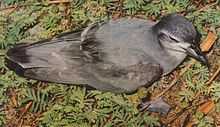Slender-billed prion
| Slender-billed prion | |
|---|---|
 | |
| Conservation status | |
| Scientific classification | |
| Kingdom: | Animalia |
| Phylum: | Chordata |
| Class: | Aves |
| Order: | Procellariiformes |
| Family: | Procellariidae |
| Genus: | Pachyptila |
| Species: | P. belcheri |
| Binomial name | |
| Pachyptila belcheri (Mathews, 1912) | |


The slender-billed prion or thin-billed prion, Pachyptila belcheri, is a species of seabird in the Procellariidae family. It is found in the southern oceans.
Taxonomy
The slender-billed prion is a member of the Pachyptila genus and along with the blue petrel make up the prions. They are then members of the Procellariiformes order, and they share certain identifying features. First, they have nasal passages that attach to the upper bill called naricorns. Although the nostrils on the prion are on top of the upper bill. The bills of Procellariiformes are also unique in that they are split into between 7 and 9 horny plates. They produce a stomach oil made up of wax esters and triglycerides that is stored in the proventriculus. This is used against predators as well as an energy rich food source for chicks and for the adults during their long flights.[2] Finally, they also have a salt gland that is situated above the nasal passage and helps desalinate their bodies, due to the high amount of ocean water that they imbibe. It excretes a high saline solution from their nose.[3]
Etymology
Pachyptila, the word, comes from the Greek words pakhus and ptilon. Pakhus means thick or stout and ptilon means a feather. Also from the Greek language, prion comes from the word priōn meaning a saw, which is in reference to its serrated edges of its bill.[4]
Description
Like all prions, they are blue-grey above and white below with a dark "M" on their back to their wingtips. They have a white eyebrow and a dark line extending from below the eye almost to the neck. Their tail is wedge-shaped and grey with a black tip, their bill is blue-grey, and their feet are pale blue.[5]
Behaviour
Reproduction
They are annual breeders and will lay one egg. Both parents will then incubate the egg and care for the young until they fledge.[6]
Feeding
Like all prions, the slender-billed eat zooplankton, by filtering it through their bill.[6]
Range and habitat
The slender-billed prion spends all of his non-breeding time over ocean water in the southern oceans. When breeding, they will do so on the Crozet Islands, the Kerguelen Islands, the Falkland islands and Noir Island off the coast of southern Chile.[7]
Conservation
This species has a very large range and their estimated population is 7,000,000, allowing the IUCN to classify them as Least Concern.[1][8]
Footnotes
- ↑ 1.0 1.1 BirdLife International (2012). "Pachyptila belcheri". IUCN Red List of Threatened Species. Version 2013.2. International Union for Conservation of Nature. Retrieved 26 November 2013.
- ↑ Double, M. C. (2003)
- ↑ Ehrlich, Paul R. (1988)
- ↑ Gotch, A. T. (1995)
- ↑ ZipCode Zoo (19 Jun 2009)
- ↑ 6.0 6.1 Maynard, B. J. (2003)
- ↑ Clements, James (2007)
- ↑ BirdLife International (2009)
References
- BirdLife International (2009). "Thin-billed Prion Pachyptila belcheri - BirdLife Species Factsheet". Data Zone. Retrieved 23 Jul 2009.
- Clements, James (2007). The Clements Checklist of the Birds of the World (6 ed.). Ithaca, NY: Cornell University Press. ISBN 978-0-8014-4501-9.
- Double, M. C. (2003). "Procellariiformes (Tubenosed Seabirds)". In Hutchins, Michael; Jackson, Jerome A.; Bock, Walter J. et al. Grzimek's Animal Life Encyclopedia. 8 Birds I Tinamous and Ratites to Hoatzins. Joseph E. Trumpey, Chief Scientific Illustrator (2 ed.). Farmington Hills, MI: Gale Group. pp. 107–111. ISBN 0-7876-5784-0.
- Ehrlich, Paul R.; Dobkin, David, S.; Wheye, Darryl (1988). The Birders Handbook (First ed.). New York, NY: Simon & Schuster. pp. 29–31. ISBN 0-671-65989-8.
- Gotch, A. F. (1995) [1979]. "Albatrosses, Fulmars, Shearwaters, and Petrels". Latin Names Explained A Guide to the Scientific Classifications of Reptiles, Birds & Mammals. New York, NY: Facts on File. p. 192. ISBN 0-8160-3377-3.
- Maynard, B. J. (2003). "Shearwaters, petrels, and fulmars (Procellariidae)". In Hutchins, Michael; Jackson, Jerome A.; Bock, Walter J. et al. Grzimek's Animal Life Encyclopedia. 8 Birds I Tinamous and Ratites to Hoatzins. Joseph E. Trumpey, Chief Scientific Illustrator (2 ed.). Farmington Hills, MI: Gale Group. pp. 123–133. ISBN 0-7876-5784-0.
- ZipCode Zoo (19 Jun 2009). "Pachyptila belcheri (Slender-Billed Prion)". BayScience Foundation. Retrieved 23 Jul 2009.
